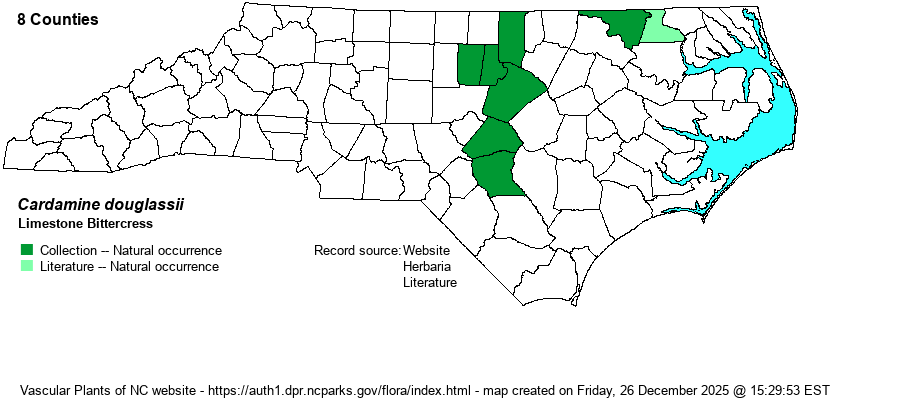| Author | Britton | |
| Distribution | Limited to a small area of the northeastern Piedmont, and along a few brownwater river floodplains into the upper Coastal Plain. Most records are for the upper Neuse River basin, in the vicinity of Falls Lake (which flooded a number of populations). Oddly lacking along the Roanoke River floodplain, but present on the Meherrin, Neuse, and Cape Fear floodplains.
This is more of a Great Lakes species, but it ranges from NY to IA, and south to NC and AL, with one record for SC and none for GA. East of the Appalachians is it decidedly local and disjunct.
| |
| Abundance | Uncommon to locally fairly common around the margins of Falls Lake and tributary floodplains (northern Wake, eastern Durham, and southern Granville counties). Rather rare and local elsewhere in the range. This is a Significantly Rare species. | |
| Habitat | This is a species mainly of floodplain forests, typically in rich bottomland forests. It does grow onto adjacent lower slopes, but normally it does not grow in swampy or in truly wet or damp ground that C. bulbosa does, nor is it strongly associated with circumneutral soils. (Perhaps this is the reason is it is lacking in the Roanoke River floodplain, as the soils may be too rich for it there.) |
| Phenology | Blooms from late February into early April, and fruits from April into May. As with all Cardamine species, the plants wither soon after fruiting and are gone from sight after early May. | |
| Identification | This species grows in very large patches, often a few thousand plants in an area, with erect stems to about 1 foot tall. It has a few basal leaves, as in C. bulbosa, with petioles a few inches long and a rounded blade about 1-inch across, with angled margins as opposed to smoothly rounded. There are only 3-4 stem leaves, these being 1-2 inches long and narrowly elliptical. Topping the stem is the flower cluster of a handful of medium-sized flowers, several flowering at a time, with 4 lavender to pink petals and a spread or length about 2/3-inch across or long. Thus, the species differs from C. bulbosa by flower color (lavender-pink versus white in that species), fewer stem leaves (3-4 versus often 5 or more), and a stem that is generally hairy toward the base (versus essentially glabrous in the other). Biologists working around the margins of Falls Lake and its tributaries are certainly familiar with this species as a spring wildflower, and the sight of thousands in bloom is quite a spectacle. | |
| Taxonomic Comments | None
| |
| Other Common Name(s) | Douglass's Bittercress, Purple Cress | |
| State Rank | S2 | |
| Global Rank | G5 | |
| State Status | SR-P | |
| US Status | | |
| USACE-agcp | OBL link |
| USACE-emp | FACW link |

